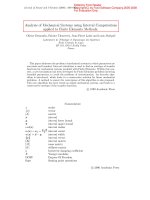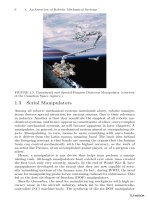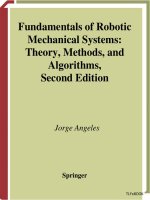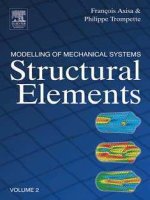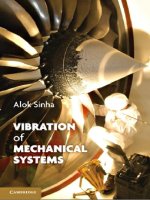Vibration of mechanical systems
Bạn đang xem bản rút gọn của tài liệu. Xem và tải ngay bản đầy đủ của tài liệu tại đây (1.55 MB, 330 trang )
This page intentionally left blank
Vibration of Mechanical Systems
This is a textbook for a first course in mechanical vibrations. There are
many books in this area that try to include everything, thus they have
become exhaustive compendiums that are overwhelming for an undergraduate. In this book, all the basic concepts in mechanical vibrations
are clearly identified and presented in a concise and simple manner with
illustrative and practical examples. Vibration concepts include a review of
selected topics in mechanics; a description of single-degree-of-freedom
(SDOF) systems in terms of equivalent mass, equivalent stiffness, and
equivalent damping; a unified treatment of various forced response problems (base excitation and rotating balance); an introduction to systems
thinking, highlighting the fact that SDOF analysis is a building block
for multi-degree-of-freedom (MDOF) and continuous system analyses
via modal analysis; and a simple introduction to finite element analysis to connect continuous system and MDOF analyses. There are more
than 60 exercise problems and a complete solutions manual. The use of
MATLAB R software is emphasized.
Alok Sinha is a Professor of Mechanical Engineering at The Pennsylvania
State University (PSU), University Park. He received his PhD degree in
mechanical engineering from Carnegie Mellon University. He has been
a PSU faculty member since August 1983. His areas of teaching and
research are vibration, control systems, jet engines, robotics, neural networks, and nanotechnology. He is the author of Linear Systems: Optimal
and Robust Control.
He has served as a Visiting Associate Professor of Aeronautics and
Astronautics at MIT, Cambridge, MA, and as a researcher at Pratt
& Whitney, East Hartford, CT. He has also been an associate editor
of ASME Journal of Dynamic Systems, Measurement, and Control. At
present, he serves as an associate editor of ASME Journal of Turbomachinery and AIAA Journal.
Alok Sinha is a Fellow of ASME. He has received the NASA certificate of recognition for significant contributions to the Space Shuttle
Microgravity Mission.
VIBRATION OF MECHANICAL
SYSTEMS
Alok Sinha
The Pennsylvania State University
CAMBRIDGE UNIVERSITY PRESS
Cambridge, New York, Melbourne, Madrid, Cape Town, Singapore,
São Paulo, Delhi, Dubai, Tokyo
Cambridge University Press
The Edinburgh Building, Cambridge CB2 8RU, UK
Published in the United States of America by Cambridge University Press, New York
www.cambridge.org
Information on this title: www.cambridge.org/9780521518734
© Alok Sinha 2010
This publication is in copyright. Subject to statutory exception and to the
provision of relevant collective licensing agreements, no reproduction of any part
may take place without the written permission of Cambridge University Press.
First published in print format 2010
ISBN-13
978-0-511-77527-7
eBook (EBL)
ISBN-13
978-0-521-51873-4
Hardback
Cambridge University Press has no responsibility for the persistence or accuracy
of urls for external or third-party internet websites referred to in this publication,
and does not guarantee that any content on such websites is, or will remain,
accurate or appropriate.
To
My Wife Hansa
and
My Daughters Divya and Swarna
CONTENTS
Preface
page xiii
1 Equivalent Single-Degree-of-Freedom System and Free
Vibration . . . . . . . . . . . . . . . . . . . . . . . . . . . . . . . . . . . . . . . . . . . . . . . . . . . . . .
1.1 Degrees of Freedom
1.2 Elements of a Vibratory System
1.2.1 Mass and/or Mass-Moment of Inertia
Pure Translational Motion
Pure Rotational Motion
Planar Motion (Combined Rotation
and Translation) of a Rigid Body
Special Case: Pure Rotation about a Fixed Point
1.2.2 Spring
Pure Translational Motion
Pure Rotational Motion
1.2.3 Damper
Pure Translational Motion
Pure Rotational Motion
1.3 Equivalent Mass, Equivalent Stiffness, and Equivalent
Damping Constant for an SDOF System
1.3.1 A Rotor–Shaft System
1.3.2 Equivalent Mass of a Spring
1.3.3 Springs in Series and Parallel
Springs in Series
Springs in Parallel
1.3.4 An SDOF System with Two Springs and Combined
Rotational and Translational Motion
1.3.5 Viscous Dampers in Series and Parallel
vii
1
3
5
5
5
6
6
8
8
8
9
10
10
11
12
13
14
16
16
17
19
22
viii
Contents
Dampers in Series
Dampers in Parallel
1.4 Free Vibration of an Undamped SDOF System
1.4.1 Differential Equation of Motion
Energy Approach
1.4.2 Solution of the Differential Equation of Motion
Governing Free Vibration of an Undamped
Spring–Mass System
1.5 Free Vibration of a Viscously Damped SDOF System
1.5.1 Differential Equation of Motion
1.5.2 Solution of the Differential Equation of Motion
Governing Free Vibration of a Damped
Spring–Mass System
Case I: Underdamped (0 < ξ < 1 or 0 < ceq < cc )
Case II: Critically Damped (ξ = 1 or ceq = cc )
Case III: Overdamped (ξ > 1 or ceq > cc )
1.5.3 Logarithmic Decrement: Identification of Damping
Ratio from Free Response of an Underdamped
System (0 < ξ < 1)
Solution
1.6 Stability of an SDOF Spring–Mass–Damper System
Exercise Problems
2 Vibration of a Single-Degree-of-Freedom System Under
Constant and Purely Harmonic Excitation . . . . . . . . . . . . . . . . . . . . . .
2.1 Responses of Undamped and Damped SDOF Systems
to a Constant Force
Case I: Undamped (ξ = 0) and Underdamped
(0 < ξ < 1)
Case II: Critically Damped (ξ = 1 or ceq = cc )
Case III: Overdamped (ξ > 1 or ceq > cc )
2.2 Response of an Undamped SDOF System
to a Harmonic Excitation
Case I: ω = ωn
Case II: ω = ωn (Resonance)
Case I: ω = ωn
Case II: ω = ωn
2.3 Response of a Damped SDOF System to a Harmonic
Excitation
Particular Solution
Case I: Underdamped (0 < ξ < 1 or 0 < ceq < cc )
22
23
25
25
27
34
40
40
41
42
45
46
51
55
58
63
72
72
74
75
76
82
83
84
87
87
88
89
92
Contents
2.4
2.5
2.6
2.7
Case II: Critically Damped (ξ = 1 or ceq = cc )
Case III: Overdamped (ξ > 1 or ceq > cc )
2.3.1 Steady State Response
2.3.2 Force Transmissibility
2.3.3 Quality Factor and Bandwidth
Quality Factor
Bandwidth
Rotating Unbalance
Base Excitation
Vibration Measuring Instruments
2.6.1 Vibrometer
2.6.2 Accelerometer
Equivalent Viscous Damping for Nonviscous Energy
Dissipation
Exercise Problems
3 Responses of an SDOF Spring–Mass–Damper System
to Periodic and Arbitrary Forces . . . . . . . . . . . . . . . . . . . . . . . . . . . . . . .
3.1 Response of an SDOF System to a Periodic Force
3.1.1 Periodic Function and its Fourier Series Expansion
3.1.2 Even and Odd Periodic Functions
Fourier Coefficients for Even Periodic Functions
Fourier Coefficients for Odd Periodic Functions
3.1.3 Fourier Series Expansion of a Function
with a Finite Duration
3.1.4 Particular Integral (Steady-State Response
with Damping) Under Periodic Excitation
3.2 Response to an Excitation with Arbitrary Nature
3.2.1 Unit Impulse Function δ(t − a)
3.2.2 Unit Impulse Response of an SDOF System
with Zero Initial Conditions
Case I: Undamped and Underdamped System
(0 ≤ ξ < 1)
Case II: Critically Damped (ξ = 1 or c eq = cc )
Case III: Overdamped (ξ > 1 or c eq > cc )
3.2.3 Convolution Integral: Response to an Arbitrary
Excitation with Zero Initial Conditions
3.2.4 Convolution Integral: Response to an Arbitrary
Excitation with Nonzero Initial Conditions
Case I: Undamped and Underdamped
(0 ≤ ξ < 1 or 0 ≤ c eq < cc )
ix
92
94
95
101
106
106
107
109
116
121
123
126
128
132
138
138
139
142
143
145
147
151
154
155
156
158
158
159
160
165
166
x
Contents
Case II: Critically Damped (ξ = 1 or c eq = cc )
Case III: Overdamped (ξ > 1 or c eq > cc )
3.3 Laplace Transformation
3.3.1 Properties of Laplace Transformation
3.3.2 Response of an SDOF System via Laplace
Transformation
3.3.3 Transfer Function and Frequency Response
Function
Significance of Transfer Function
Poles and Zeros of Transfer Function
Frequency Response Function
Exercise Problems
166
166
168
169
170
173
175
175
176
179
4 Vibration of Two-Degree-of-Freedom-Systems . . . . . . . . . . . . . . . . .
4.1 Mass, Stiffness, and Damping Matrices
4.2 Natural Frequencies and Mode Shapes
4.2.1 Eigenvalue/Eigenvector Interpretation
4.3 Free Response of an Undamped 2DOF System
Solution
4.4 Forced Response of an Undamped 2DOF System Under
Sinusoidal Excitation
4.5 Free Vibration of a Damped 2DOF System
4.6 Steady-State Response of a Damped 2DOF System
Under Sinusoidal Excitation
4.7 Vibration Absorber
4.7.1 Undamped Vibration Absorber
4.7.2 Damped Vibration Absorber
Case I: Tuned Case ( f = 1 or ω22 = ω11 )
Case II: No restriction on f (Absorber not tuned
to main system)
4.8 Modal Decomposition of Response
Case I: Undamped System (C = 0)
Case II: Damped System (C = 0)
Exercise Problems
186
187
192
197
198
200
5 Finite and Infinite (Continuous) Dimensional Systems . . . . . . . . . .
5.1 Multi-Degree-of-Freedom Systems
5.1.1 Natural Frequencies and Modal Vectors
(Mode Shapes)
5.1.2 Orthogonality of Eigenvectors for Symmetric Mass
and Symmetric Stiffness Matrices
237
237
201
203
209
212
212
220
224
224
227
228
228
231
239
242
Contents
5.1.3 Modal Decomposition
Case I: Undamped System (C = 0)
Case II: Proportional or Rayleigh Damping
5.2 Continuous Systems Governed by Wave Equations
5.2.1 Transverse Vibration of a String
Natural Frequencies and Mode Shapes
Computation of Response
5.2.2 Longitudinal Vibration of a Bar
5.2.3 Torsional Vibration of a Circular Shaft
5.3 Continuous Systems: Transverse Vibration of a Beam
5.3.1 Governing Partial Differential Equation of Motion
5.3.2 Natural Frequencies and Mode Shapes
Simply Supported Beam
Cantilever Beam
5.3.3 Computation of Response
5.4 Finite Element Analysis
5.4.1 Longitudinal Vibration of a Bar
Total Kinetic and Potential Energies of the Bar
5.4.2 Transverse Vibration of a Beam
Total Kinetic and Potential Energies of the Beam
Exercise Problems
xi
245
246
249
250
250
251
255
258
261
265
265
267
269
271
273
279
279
283
286
291
295
APPENDIX A: EQUIVALENT STIFFNESSES (SPRING
CONSTANTS) OF BEAMS, TORSIONAL SHAFT, AND
LONGITUDINAL BAR . . . . . . . . . . . . . . . . . . . . . . . . . . . . . . . . . . . . . . . . . . . . . . . . . . . . 299
APPENDIX B: SOME MATHEMATICAL FORMULAE . . . . . . . . . . . . . . . . .
302
APPENDIX C: LAPLACE TRANSFORM TABLE . . . . . . . . . . . . . . . . . . . . . . . . 304
References
305
Index
307
PREFACE
This book is intended for a vibration course in an undergraduate
Mechanical Engineering curriculum. It is based on my lecture notes
of a course (ME370) that I have been teaching for many years at The
Pennsylvania State University (PSU), University Park. This vibration
course is a required core course in the PSU mechanical engineering
curriculum and is taken by junior-level or third-year students. Textbooks that have been used at PSU are as follows: Hutton (1981) and
Rao (1995, First Edition 1986). In addition, I have used the book by
Thomson and Dahleh (1993, First Edition 1972) as an important reference book while teaching this course. It will be a valid question if one
asks why I am writing another book when there are already a large
number of excellent textbooks on vibration since Den Hartog wrote
the classic book in 1956. One reason is that most of the books are
intended for senior-level undergraduate and graduate students. As a
result, our faculties have not found any book that can be called ideal
for our junior-level course. Another motivation for writing this book is
that I have developed certain unique ways of presenting vibration concepts in response to my understanding of the background of a typical
undergraduate student in our department and the available time during a semester. Some of the examples are as follows: review of selected
topics in mechanics; the description of the chapter on single-degreeof-freedom (SDOF) systems in terms of equivalent mass, equivalent
stiffness, and equivalent damping; unified treatment of various forced
xiii
xiv
Preface
response problems such as base excitation and rotating balance; introduction of system thinking, highlighting the fact that SDOF analysis
is a building block for multi-degree-of-freedom (MDOF) and continuous system analyses via modal analysis; and a simple introduction
of finite element analysis to connect continuous system and MDOF
analyses.
As mentioned before, there are a large number of excellent books
on vibration. But, because of a desire to include everything, many of
these books often become difficult for undergraduate students. In this
book, all the basic concepts in mechanical vibration are clearly identified and presented in a simple manner with illustrative and practical examples. I have also attempted to make this book self-contained
as much as possible; for example, materials needed from previous
courses, such as differential equation and engineering mechanics, are
presented. At the end of each chapter, exercise problems are included.
The use of MATLAB software is also included.
ORGANIZATION OF THE BOOK
In Chapter 1, the degrees of freedom and the basic elements of
a vibratory mechanical system are presented. Then the concepts
of equivalent mass, equivalent stiffness, and equivalent damping
are introduced to construct an equivalent single-degree-of-freedom
model. Next, the differential equation of motion of an undamped
SDOF spring–mass system is derived along with its solution. Then the
solution of the differential equation of motion of an SDOF spring–
mass–damper system is obtained. Three cases of damping levels –
underdamped, critically damped, and overdamped – are treated in
detail. Last, the concept of stability of an SDOF spring–mass–damper
system is presented.
In Chapter 2, the responses of undamped and damped SDOF
spring–mass systems are presented. An important example of input
shaping is shown. Next, the complete solutions of both undamped and
Preface
xv
damped spring–mass systems under sinusoidal excitation are derived.
Amplitudes and phases of steady-state responses are examined along
with force transmissibility, quality factor, and bandwidth. Then the
solutions to rotating unbalance and base excitation problems are provided. Next, the basic principles behind the designs of a vibrometer
and an accelerometer are presented. Last, the concept of equivalent
viscous damping is presented for nonviscous energy dissipation.
In Chapter 3, the techniques to compute the response of an SDOF
system to a periodic excitation are presented via the Fourier series
expansion. Then it is shown how the response to an arbitrary excitation is obtained via the convolution integral and the unit impulse
response. Last, the Laplace transform technique is presented. The
concepts of transfer function, poles, zeros, and frequency response
function are also introduced.
In Chapter 4, mass matrix, stiffness matrix, damping matrix, and
forcing vector are defined. Then the method to compute the natural
frequencies and the mode shapes is provided. Next, free and forced
vibration of both undamped and damped two-degree-of-freedom systems are analyzed. Last, the techniques to design undamped and
damped vibration absorbers are presented.
In Chapter 5, the computation of the natural frequencies and the
mode shapes of discrete multi-degree-of-freedom and continuous systems is illustrated. Then the orthogonality of the mode shapes is
shown. The method of modal decomposition is presented for the computation of both free and forced responses. The following cases of
continuous systems are considered: transverse vibration of a string,
longitudinal vibration of a bar, torsional vibration of a circular shaft,
and transverse vibration of a beam. Last, the finite element method is
introduced via examples of the longitudinal vibration of a bar and the
transverse vibration of a beam.
1
EQUIVALENT
SINGLE-DEGREE-OF-FREEDOM
SYSTEM AND FREE VIBRATION
The course on Mechanical Vibration is an important part of the
Mechanical Engineering undergraduate curriculum. It is necessary
for the development and the performance of many modern engineering products: automobiles, jet engines, rockets, bridges, electric
motors, electric generators, and so on. Whenever a mechanical system contains storage elements for kinetic and potential energies, there
will be vibration. The vibration of a mechanical system is a continual exchange between kinetic and potential energies. The vibration
level is reduced by the presence of energy dissipation elements in the
system. The problem of vibration is further accentuated because of
the presence of time-varying external excitations, for example, the
problem of resonance in a rotating machine, which is caused by the
inevitable presence of rotor unbalance. There are many situations
where the vibration is caused by internal excitation, which is dependent on the level of vibration. This type of vibration is known as selfexcited oscillations, for example, the failure of the Tacoma suspension
bridge (Billah and Scanlan, 1991) and the fluttering of an aircraft wing.
This course deals with the characterization and the computation of the
response of a mechanical system caused by time-varying excitations,
which can be independent of or dependent on vibratory response.
In general, the vibration level of a component of a machine has to
be decreased to increase its useful life. As a result, the course also
1
2
Vibration of Mechanical Systems
examines the methods used to reduce vibratory response. Further, this
course also develops an input/output description of a dynamic system,
which is useful for the design of a feedback control system in a future
course in the curriculum.
The book starts with the definition of basic vibration elements
and the vibration analysis of a single-degree-of-freedom (SDOF) system, which is the simplest lumped parameter mechanical system and
contains one independent kinetic energy storage element (mass), one
independent potential energy storage element (spring), and one independent energy dissipation element (damper). The analysis deals
with natural vibration (without any external excitation) and forced
response as well. The following types of external excitations are considered: constant, sinusoidal, periodic, and impulsive. In addition,
an arbitrary nature of excitation is considered. Then, these analyses
are presented for a complex lumped parameter mechanical system
with multiple degrees of freedom (MDOF). The design of vibration
absorbers is presented. Next, the vibration of a system with continuous distributions of mass, such as strings, longitudinal bars, torsional
shafts, and beams, is presented. It is emphasized that the previous
analyses of lumped parameter systems serve as building blocks for
computation of the response of a continuous system that is governed
by a partial differential equation. Last, the fundamentals of finite element analysis (FEA), which is widely used for vibration analysis of a
real structure with a complex shape, are presented. This presentation
again shows the application of concepts developed in the context of
SDOF and MDOF systems to FEA.
In this chapter, we begin with a discussion of degrees of freedom
and the basic elements of a vibratory mechanical system that are a
kinetic energy storage element (mass), a potential energy storage element (spring), and an energy dissipation element (damper). Then,
an SDOF system with many energy storage and dissipation elements,
which are not independent, is considered. It is shown how an equivalent SDOF model with one equivalent mass, one equivalent spring,
Equivalent Single-Degree-of-Freedom System and Free Vibration
3
and one equivalent damper is constructed to facilitate the derivation
of the differential equation of motion. Next, the differential equation
of motion of an undamped SDOF spring–mass system is derived along
with its solution to characterize its vibratory behavior. Then, the solution of the differential equation of motion of an SDOF spring–mass–
damper system is obtained and the nature of the response is examined as a function of damping values. Three cases of damping levels, underdamped, critically damped, and overdamped, are treated in
detail. Last, the concept of stability of an SDOF spring–mass–damper
system is presented along with examples of self-excited oscillations
found in practice.
1.1 DEGREES OF FREEDOM
Degrees of freedom (DOF) are the number of independent coordinates
that describe the position of a mechanical system at any instant of time.
For example, the system shown in Figure 1.1.1 has one degree of freedom x, which is the displacement of the mass m1 . In spite of the two
masses m1 and m2 in Figure 1.1.2, this system has only one degree of
freedom x because both masses are connected by a rigid link, and the
displacements of both masses are not independent. The system shown
in Figure 1.1.3 has two degrees of freedom x1 and x2 because both
masses m1 and m2 are connected by a flexible link or a spring, and the
displacements of both masses are independent.
Next, consider rigid and flexible continuous cantilever beams as
shown in Figures 1.1.4 and 1.1.5. The numbers of degrees of freedom
for rigid and flexible beams are 0 and ∞, respectively. Each continuous beam can be visualized to contain an infinite number of point
masses. These point masses are connected by rigid links for a rigid
beam as shown in Figure 1.1.2, whereas they are connected by flexible
links for a flexible beam as shown in Figure 1.1.3. Consequently, there
is one degree of freedom associated with each of the point masses in
a flexible beam.
4
Vibration of Mechanical Systems
Massless
spring
x
m1
DOF = 1
Figure 1.1.1 An SDOF system with a single mass
Massless
spring
Rigid link
x
x
m1
DOF = 1
m2
Figure 1.1.2 An SDOF system with two masses
Massless
spring
x1
Massless
spring
m1
x2
m2
DOF = 2
Figure 1.1.3 Two DOF systems with two masses
Point masses connected by rigid links
.......
DOF = 0
Rigid beam
Figure 1.1.4 A rigid beam fixed at one end
Point masses connected by flexible links
.. .. ...
DOF = ∞
Flexible beam
Figure 1.1.5 A flexible beam fixed at one end
5
Equivalent Single-Degree-of-Freedom System and Free Vibration
x(t)
f (t)
m
Figure 1.2.1 A mass in pure translation
1.2 ELEM ENTS OF A VIBRATORY SYSTEM
There are three basic elements of a vibratory system: a kinetic energy
storage element (mass), a potential energy storage element (spring),
and an energy dissipation element (damper). The description of each
of these three basic elements is as follows.
1.2.1 Mass and/or Mass-Moment of Inertia
Newton’s second law of motion and the expression of kinetic energy
are presented for three types of motion: pure translational motion,
pure rotational motion, and planar (combined translational and rotational) motion.
Pure Translational Motion
Consider the simple mass m (Figure 1.2.1) which is acted upon by a
force f (t).
Applying Newton’s second law of motion,
mx = f (t)
ă
(1.2.1)
where
x=
dx
dt
and
x=
ă
d2x
dt2
(1.2.2a, b)
The energy of the mass is stored in the form of kinetic energy (KE):
KE =
1 2
mx
˙
2
(1.2.3)
6
Vibration of Mechanical Systems
σeq
feq
O
l
r cos θ
r
θ
vc
C
mg
θ
&
θ=ω
Figure 1.2.2 A mass in pure rotation
Pure Rotational Motion
Consider the mass m (Figure 1.2.2) which is pinned at the point O,
and acted upon by an equivalent external force feq and an equivalent
external moment σeq . This mass is undergoing a pure rotation about
the point O, and Newtons second law of motion leads to
ă
Io = mgr sin θ + feq + σeq
(1.2.4)
where Io is the mass-moment of inertia about the center of rotation O,
θ is the angular displacement, and is the length of the perpendicular
from the point O to the line of force.
The KE of the rigid body is
1 2
˙
I oθ
2
The potential energy (PE) of the rigid body is
KE =
PE = mg(r − r cos θ )
(1.2.5)
(1.2.6)
Planar Motion (Combined Rotation and Translation)
of a Rigid Body
Consider the planar motion of a rigid body with mass m and the massmoment of inertia Ic about the axis perpendicular to the plane of
motion and passing through the center of mass C (Figure 1.2.3). Forces
fi , i = 1, 2, . . . , nf , and moments σi , i = 1, 2, . . . , nt , are acting on this
Equivalent Single-Degree-of-Freedom System and Free Vibration
7
f3
σ1
vc
ω
C
f1
σ2
y
σ3
f2
x
Figure 1.2.3 Planar motion of a rigid body
rigid body. Let xc and yc be x- and y- coordinates of the center of
mass C with respect to the fixed x−y frame. Then, Newton’s second
law of motion for the translational part of motion is given by
mx c =
ă
fxi (t)
(1.2.7)
f yi (t)
(1.2.8)
i
myc =
ă
i
where fxi and f yi are x- and y- components of the force fi . Newton’s
second law of motion for the rotational part of motion is given by
ă
Ic = Ic =
i (t) +
i
fc
i
(1.2.9)
i
where fc is the moment of the force fi about the center of mass C.
i
And, θ and ω are the angular position and the angular velocity of the
rigid body, respectively. The KE of a rigid body in planar motion is
given by
KE =
1 2 1
mv + Ic ω2
2 c 2
(1.2.10)
where vc is the magnitude of the linear velocity of the center of mass,
that is,
2
˙c ˙ 2
vc = x 2 + yc
(1.2.11)


